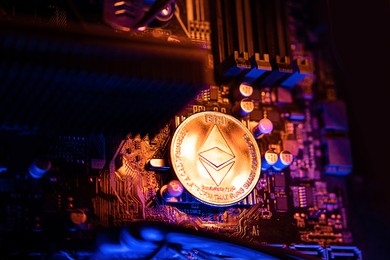Ethereum
Researcher Successfully Syncs Ethereum Node On PlayStation 4

[ad_1]
In a groundbreaking experiment, Mario Havel, a protocol supporter and researcher of the Ethereum (ETH) Foundation, has achieved the synchronization of an ETH node on an unlikely device – a PlayStation 4 gaming console.
According to a recent post, Havel’s journey began with delving into “PlayStation jailbreaking,” where he discovered vulnerabilities in older PlayStation 4 firmware that allowed for control takeover.
Jailbreaking refers to bypassing the restrictions imposed by the official software (firmware) of a device, in this case, a PlayStation 4 console.
By jailbreaking the console, the researcher, Mario Havel, gained unauthorized access to the system, allowing him to run custom software and applications and make modifications not typically allowed by the manufacturer.
Armed with an “old PlayStation 4 machine” running firmware 9.00 or older, Havel embarked on a mission to transform the gaming console into a fully functional Ethereum node.
From Gaming To Blockchain
The initial challenge was to obtain a “suitable, hackable” PlayStation 4 console with the desired firmware version. Havel emphasized the importance of avoiding system updates, as newer firmware versions are incompatible with the exploit.
After acquiring the appropriate console, Havel manually installed the 9.00 firmware using a USB drive, ensuring the machine remained offline to prevent unwanted updates.
To prevent automatic updates while connected to the internet, Havel recommended using a custom domain name system (DNS) server that blocks updates and redirects the user guide homepage to an exploit host.
This setup allowed Havel to host a website locally or publicly, providing the necessary tools and resources for the PlayStation 4 jailbreaking process.
The jailbreaking process relied on an exploit discovered by comparing firmware versions 9.00 and 9.03. By exploiting a filesystem bug, Havel could trigger the vulnerability by inserting a specially formatted USB device immediately.
The exploit required an exfathax.IMG file, which could be downloaded and flashed onto a USB drive using software such as Balena Etcher, a cross-platform tool. Havel noted that the USB drive would be formatted during each jailbreaking session, and it was advisable to use a dedicated flash drive for this purpose.
According to Havel, once the exploit was successfully activated, the PlayStation 4 gained new capabilities, allowing it to install various packages, tools, and games directly on the console.
Linux-Based Ethereum Node Hosting
Havel mentioned the ability to install packages over a local network for a “smoother installation process.” He also highlighted the ability to run a GNU/Linux distribution – an operating system that can interact with computers and run other programs – on the PlayStation 4, turning it into a versatile personal computer.
With Linux successfully running on the PlayStation 4, Havel set up an Ethereum node on the console. He recommended downloading portable versions or compiling Ethereum clients suitable for the PlayStation 4’s GNU/Linux environment.
Havel shared his experience with clients, highlighting the importance of optimizing resource consumption for smoother operations. He also mentioned monitoring applications to ensure optimal temperature and fan control.
Having established secure shell (SSH) access over the local network, Havel could connect to his PlayStation 4 node from his laptop, treating it like any other server.
This setup allowed for continuous Ethereum synchronization and showcased the PlayStation 4’s potential as a dedicated node-hosting device.
Ultimately, by repurposing a PlayStation 4 as an Ethereum node, Havel has opened up new possibilities for node hosting, decentralization, and utilizing existing hardware for blockchain network participation.
As the experimentation continues, researchers and enthusiasts will likely explore similar avenues, pushing the boundaries of what can be achieved with gaming consoles and decentralized technologies.
Featured image from Shutterstock, chart from TradingView.com
[ad_2]
Source link









